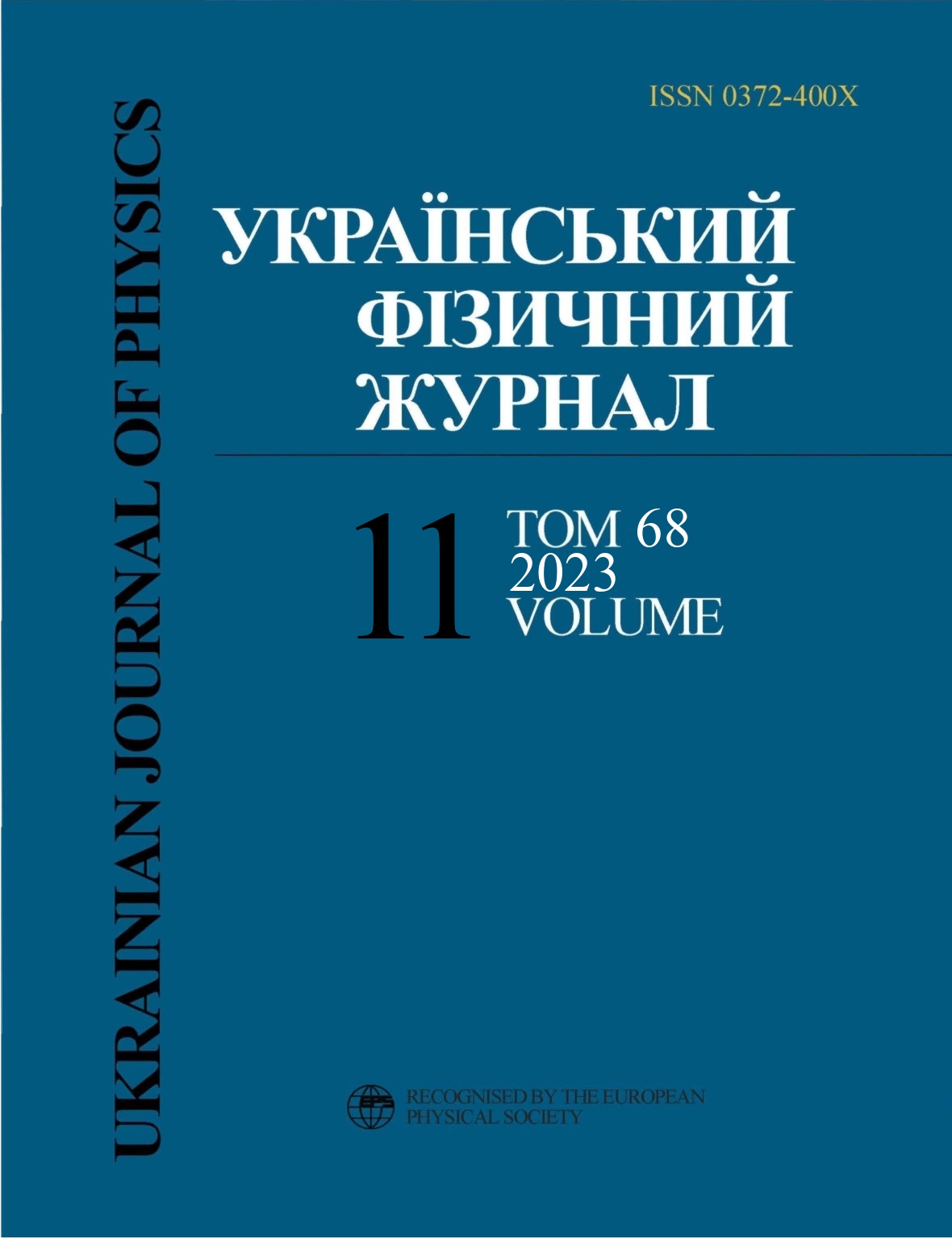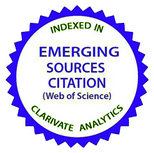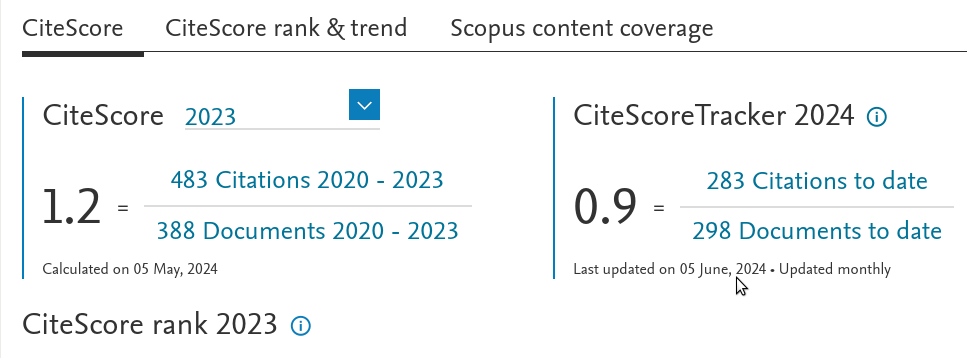Генерація хіральної асиметрії під час аксіонної інфляції
DOI:
https://doi.org/10.15407/ujpe68.11.717Ключові слова:
аксiонна iнфляцiя, формалiзм градiєнтного розкладу, ефект Швiнгера, хiральна аномалiя, хiральна асиметрiяАнотація
Ми дослiдили генерацiю хiрального заряду пiд час аксiонної iнфляцiї, де псевдоскалярне поле iнфлатона φ взаємодiє аксiально з електромагнiтним полем через доданок (β/Mp)φ E · B з безрозмiрною константою зв’язку β. Щоб описати еволюцiю електромагнiтного поля та визначити величину ⟨E · B⟩, яка завдяки хiральнiй аномалiї є джерелом хiральної асиметрiї пiд час iнфляцiї, ми використовуємо формалiзм градiєнтного розкладу. Вiн працює з набором вакуумних середнiх вiд бiлiнiйних електромагнiтних функцiй i дозволяє враховувати зворотну реакцiю згенерованих полiв на еволюцiю iнфлатона, а також швiнгерiвське народження заряджених фермiонiв. Крiм того, ми припускаємо, що згенерованi фермiони термалiзуються та внаслiдок хiрального магнiтного ефекту дають внесок до електричного струму, jCME = e2/(2π2)μ5B, де μ5 – хiральний хiмiчний потенцiал, який кiлькiсно визначає створену хiральну асиметрiю. Розв’язуючи систему рiвнянь для поля iнфлатона, масштабного фактора, бiлiнiйних функцiй електромагнiтного поля та хiральної густини заряду (хiрального хiмiчного потенцiалу), ми знаходимо, що генерацiя хiральної асиметрiї є досить ефективною, що вiдображається у великих значеннях хiрального хiмiчного потенцiалу в кiнцi аксiонної iнфляцiї.
Посилання
E.R. Harrison. Fluctuations at the threshold of classical cosmology. Phys. Rev. D 1, 2726 (1970).
https://doi.org/10.1103/PhysRevD.1.2726
Ya.B. Zeldovich. A hypothesis, unifying the structure and the entropy of the Universe. Mon. Not. R. Astron. Soc. 160, 1P (1972).
https://doi.org/10.1093/mnras/160.1.1P
G.V. Chibisov, V.F. Mukhanov. Galaxy formation and phonons, Mon. Not. R. Astron. Soc. 200, 535 (1982).
https://doi.org/10.1093/mnras/200.3.535
V.F. Mukhanov, H.A. Feldman, R.H. Brandenberger. Theory of cosmological perturbations. Part 1. Classical perturbations. Part 2. Quantum theory of perturbations. Part 3. Extensions, Phys. Rep. 215, 203 (1992).
https://doi.org/10.1016/0370-1573(92)90044-Z
R. Durrer. The Cosmic Microwave Background (Cambridge University Press, 2008).
https://doi.org/10.1017/CBO9780511817205
M.S. Turner, L.M. Widrow. Inflation-produced, large-scale magnetic fields. Phys. Rev. D 37, 2743 (1988).
https://doi.org/10.1103/PhysRevD.37.2743
B. Ratra. Cosmological "seed" magnetic field from inflation. Astrophys. J. 391, L1 (1992).
https://doi.org/10.1086/186384
W.D. Garretson, G.B. Field, S.M. Carroll. Primordial magnetic fields from pseudo-Goldstone bosons. Phys. Rev. D 46, 5346 (1992).
https://doi.org/10.1103/PhysRevD.46.5346
A.D. Dolgov. Breaking of conformal invariance and electromagnetic field generation in the Universe. Phys. Rev. D 48, 2499 (1993).
https://doi.org/10.1103/PhysRevD.48.2499
D. Grasso, H.R. Rubinstein. Magnetic fields in the early Universe. Phys. Rep. 348, 163 (2001).
https://doi.org/10.1016/S0370-1573(00)00110-1
P.P. Kronberg. Extragalactic magnetic fields. Rep. Prog. Phys. 57, 325 (1994).
https://doi.org/10.1088/0034-4885/57/4/001
L.M. Widrow. Origin of galactic and extragalactic magnetic fields. Rev. Mod. Phys. 74, 775 (2002).
https://doi.org/10.1103/RevModPhys.74.775
M. Giovannini. The magnetized Universe. Int. J. Mod. Phys. D 13, 391 (2004).
https://doi.org/10.1142/S0218271804004530
A. Kandus, K.E. Kunze, C.G. Tsagas. Primordial magnetogenesis. Phys. Rep. 505, 1 (2011).
https://doi.org/10.1016/j.physrep.2011.03.001
J.P. Vall'ee. Magnetic fields in the galactic Universe, as observed in supershells, galaxies, intergalactic and cosmic realms. New Astron. Rev. 55, 91 (2011).
https://doi.org/10.1016/j.newar.2011.01.002
D. Ryu, D.R.G. Schleicher, R.A. Treumann, C.G. Tsagas, L.M. Widrow. Magnetic fields in the large-scale structure of the Universe. Space Sci. Rev. 166, 1 (2012).
https://doi.org/10.1007/s11214-011-9839-z
R. Durrer, A. Neronov. Cosmological magnetic fields: Their generation, evolution and observation. Astron. Astrophys. Rev. 21, 62 (2013).
https://doi.org/10.1007/s00159-013-0062-7
K. Subramanian. The origin, evolution and signatures of primordial magnetic fields. Rep. Prog. Phys. 79, 076901 (2016).
https://doi.org/10.1088/0034-4885/79/7/076901
F. Tavecchio, G. Ghisellini, L. Foschini, G. Bonnoli, G. Ghirlanda, P. Coppi. The intergalactic magnetic field constrained by Fermi/Large Area Telescope observations of the TeV blazar 1ES 0229+200. Mon. Not. R. Astron. Soc. 406, L70 (2010).
https://doi.org/10.1111/j.1745-3933.2010.00884.x
S. Ando, A. Kusenko. Evidence for gamma-ray halos around active galactic nuclei and the first measurement of intergalactic magnetic fields. Astrophys. J. Lett. 722, L39 (2010).
https://doi.org/10.1088/2041-8205/722/1/L39
A. Neronov, I. Vovk. Evidence for strong extragalactic magnetic fields from Fermi observations of TeV blazars. Science 328, 73 (2010).
https://doi.org/10.1126/science.1184192
F. Tavecchio, G. Ghisellini, G. Bonnoli, L. Foschini. Extreme TeV blazars and the intergalactic magnetic field. Mon. Not. R. Astron. Soc. 414, 3566 (2011).
https://doi.org/10.1111/j.1365-2966.2011.18657.x
K. Dolag, M. Kachelriess, S. Ostapchenko, R. Tomas. Lower limit on the strength and filling factor of extragalactic magnetic fields. Astrophys. J. Lett. 727, L4 (2011).
https://doi.org/10.1088/2041-8205/727/1/L4
C.D. Dermer, M. Cavadini, S. Razzaque, J.D. Finke, J. Chiang, B. Lott. Time delay of cascade radiation for TeV blazars and the measurement of the intergalactic magnetic field. Astrophys. J. Lett. 733, L21 (2011).
https://doi.org/10.1088/2041-8205/733/2/L21
A.M. Taylor, I. Vovk, A. Neronov. Extragalactic magnetic fields constraints from simultaneous GeV-TeV observations of blazars. Astron. Astrophys. 529, A144 (2011).
https://doi.org/10.1051/0004-6361/201116441
H. Huan, T. Weisgarber, T. Arlen, S.P. Wakely. A new model for gamma-ray cascades in extragalactic magnetic fields. Astrophys. J. Lett. 735, L28 (2011).
https://doi.org/10.1088/2041-8205/735/2/L28
I. Vovk, A.M. Taylor, D. Semikoz, A. Neronov. Fermi/LAT observations of 1ES 0229+200: Implications for extragalactic magnetic fields and background light. Astrophys. J. Lett. 747, L14 (2012).
https://doi.org/10.1088/2041-8205/747/1/L14
C. Caprini, S. Gabici. Gamma-ray observations of blazars and the intergalactic magnetic field spectrum. Phys. Rev. D 91, 123514 (2015).
https://doi.org/10.1103/PhysRevD.91.123514
R.A. Batista, A. Saveliev. The gamma-ray window to intergalactic magnetism. Universe 7, 223 (2021).
https://doi.org/10.3390/universe7070223
M.M. Anber, L. Sorbo. N-flationary magnetic fields. J. Cosmol. Astropart. Phys. 10, 018 (2006).
https://doi.org/10.1088/1475-7516/2006/10/018
M.M. Anber, L. Sorbo. Naturally inflating on steep potentials through electromagnetic dissipation. Phys. Rev. D 81, 043534 (2010).
https://doi.org/10.1103/PhysRevD.81.043534
R. Durrer, L. Hollenstein, R.K. Jain. Can slow roll inflation induce relevant helical magnetic fields? J. Cosmol. Astropart. Phys. 03, 037 (2011).
https://doi.org/10.1088/1475-7516/2011/03/037
N. Barnaby, E. Pajer, M. Peloso. Gauge field production in axion inflation: consequences for monodromy, nonGaussianity in the CMB, and gravitational waves at interferometers. Phys. Rev. D 85, 023525 (2012).
https://doi.org/10.1103/PhysRevD.85.023525
C. Caprini, L. Sorbo. Adding helicity to inflationary magnetogenesis. J. Cosmol. Astropart. Phys. 10, 056 (2014).
https://doi.org/10.1088/1475-7516/2014/10/056
M.M. Anber, E. Sabancilar. Hypermagnetic fields and baryon asymmetry from pseudoscalar inflation. Phys. Rev. D 92, 101501(R) (2015).
https://doi.org/10.1103/PhysRevD.92.101501
K.-W. Ng, S.-L. Cheng, W. Lee. Inflationary dilaton-axion magnetogenesis. Chin. J. Phys. 53, 110105 (2015).
T. Fujita, R. Namba, Y. Tada, N. Takeda, H. Tashiro. Consistent generation of magnetic fields in axion inflation models. J. Cosmol. Astropart. Phys. 05, 054 (2015).
https://doi.org/10.1088/1475-7516/2015/05/054
P. Adshead, J.T. Giblin, Jr., T.R. Scully, E.I. Sfakianakis. Gauge-preheating and the end of axion inflation. J. Cosmol. Astropart. Phys. 12, 034 (2015).
https://doi.org/10.1088/1475-7516/2015/12/034
P. Adshead, J.T. Giblin, Jr., T.R. Scully, E.I. Sfakianakis. Magnetogenesis from axion inflation. J. Cosmol. Astropart. Phys. 10, 039 (2016).
https://doi.org/10.1088/1475-7516/2016/10/039
A. Notari, K. Tywoniuk. Dissipative axial inflation. J. Cosmol. Astropart. Phys. 12, 038 (2016).
https://doi.org/10.1088/1475-7516/2016/12/038
D. Jim'enez, K. Kamada, K. Schmitz, X. Xu. Baryon asymmetry and gravitational waves from pseudoscalar inflation. J. Cosmol. Astropart. Phys. 12, 011 (2017).
https://doi.org/10.1088/1475-7516/2017/12/011
V. Domcke, K. Mukaida. Gauge field and fermion production during axion inflation. J. Cosmol. Astropart. Phys. 11, 020 (2018).
https://doi.org/10.1088/1475-7516/2018/11/020
J.R.C. Cuissa, D.G. Figueroa. Lattice formulation of axion inflation. Application to preheating. J. Cosmol. Astropart. Phys. 06, 002 (2019).
https://doi.org/10.1088/1475-7516/2019/06/002
Yu. Shtanov. Viable inflationary magnetogenesis with helical coupling. J. Cosmol. Astropart. Phys. 10, 008 (2019).
https://doi.org/10.1088/1475-7516/2019/10/008
Y.V. Shtanov, M.V. Pavliuk. Inflationary magnetogenesis with helical coupling. Ukr. J. Phys. 64 (11), 1009 (2019).
https://doi.org/10.15407/ujpe64.11.1009
O.O. Sobol, E.V. Gorbar, S.I. Vilchinskii. Backreaction of electromagnetic fields and the Schwinger effect in pseudoscalar inflation magnetogenesis. Phys. Rev. D 100, 063523 (2019).
https://doi.org/10.1103/PhysRevD.100.063523
V. Domcke, B. von Harling, E. Morgante, K. Mukaida. Baryogenesis from axion inflation. J. Cosmol. Astropart. Phys. 10, 032 (2019).
https://doi.org/10.1088/1475-7516/2019/10/032
V. Domcke, Y. Ema, K. Mukaida. Chiral anomaly, Schwinger effect, Euler-Heisenberg lagrangian, and application to axion inflation. J. High Energy Phys. 02, 055 (2020).
https://doi.org/10.1007/JHEP02(2020)055
V. Domcke, V. Guidetti, Y. Welling, A. Westphal. Resonant backreaction in axion inflation. J. Cosmol. Astropart. Phys. 09, 009 (2020).
https://doi.org/10.1088/1475-7516/2020/09/009
E.V. Gorbar, K. Schmitz, O.O. Sobol, S.I. Vilchinskii. Gauge-field production during axion inflation in the gradient expansion formalism. J. High Energy Phys. 02, 055 (2020).
https://doi.org/10.1103/PhysRevD.104.123504
M. Joyce, M.E. Shaposhnikov. Primordial magnetic fields, right-handed electrons, and the abelian anomaly. Phys. Rev. Lett. 79, 1193 (1997).
https://doi.org/10.1103/PhysRevLett.79.1193
A. Boyarsky, J. Fr¨ohlich, O. Ruchayskiy. Self-consistent evolution of magnetic fields and chiral asymmetry in the early universe. Phys. Rev. Lett. 108, 031301 (2012).
https://doi.org/10.1103/PhysRevLett.108.031301
R. Banerjee, K. Jedamzik. Evolution of cosmic magnetic fields: From the very early Universe, to recombination, to the present. Phys. Rev. D 70, 123003 (2004).
https://doi.org/10.1103/PhysRevD.70.123003
H. Tashiro, T. Vachaspati, A. Vilenkin. Chiral effects and cosmic magnetic fields. Phys. Rev. D 86, 105033 (2012).
https://doi.org/10.1103/PhysRevD.86.105033
Y. Hirono, D. Kharzeev, Y. Yin. Self-similar inverse cascade of magnetic helicity driven by the chiral anomaly. Phys. Rev. D 92, 125031 (2015).
https://doi.org/10.1103/PhysRevD.92.125031
M. Dvornikov, V. B. Semikoz. Influence of the turbulent motion on the chiral magnetic effect in the early Universe. Phys. Rev. D 95, 043538 (2017).
https://doi.org/10.1103/PhysRevD.95.043538
E. V. Gorbar, I. Rudenok, I. A. Shovkovy, and S. Vilchinskii, Anomaly-driven inverse cascade and inhomogeneities in a magnetized chiral plasma in the early Universe. Phys. Rev. D 94, 103528 (2016).
https://doi.org/10.1103/PhysRevD.94.103528
A. Brandenburg, J. Schober, I. Rogachevskii, T. Kahniashvili, A. Boyarsky, J. Fr¨ohlich, O. Ruchayskiy, N. Kleeorin. The turbulent chiral-magnetic cascade in the early Universe. Astrophys. J. Lett. 845, L21 (2017).
https://doi.org/10.3847/2041-8213/aa855d
J. Schober, A. Brandenburg, I. Rogachevskii. Chiral fermion asymmetry in high-energy plasma simulations. Geophys. Astrophys. Fluid Dyn. 114, 106 (2020).
https://doi.org/10.1080/03091929.2019.1591393
L. Parker. Particle creation in expanding universes. Phys. Rev. Lett. 21, 562 (1968).
https://doi.org/10.1103/PhysRevLett.21.562
F. Sauter. ¨Uber das Verhalten eines Elektrons im homogenen elektrischen Feld nach der relativistischen Theorie Diracs (On the behavior of an electron in the homogeneous electric field according to the relativistic theory of Dirac), Z. Phys. 69, 742 (1931).
https://doi.org/10.1007/BF01339461
W. Heisenberg, H. Euler. Folgerungen aus der Diracschen Theorie des Positrons (Conclusions from Dirac's theory of the positron). Z. Phys. 98, 714 (1936).
https://doi.org/10.1007/BF01343663
J. Schwinger. On gauge invariance and vacuum polarization. Phys. Rev. 82, 664 (1951).
https://doi.org/10.1103/PhysRev.82.664
S.L. Adler. Axial vector vertex in spinor electrodynamics. Phys. Rev. 177, 2426 (1969).
https://doi.org/10.1103/PhysRev.177.2426
J.S. Bell, R. Jackiw. A PCAC puzzle: π0→ γγ in the σ model. Nuovo Cim. A 60, 47 (1969).
https://doi.org/10.1007/BF02823296
T. Kobayashi, N. Afshordi. Schwinger effect in 4D de Sitter space and constraints on magnetogenesis in the early universe. J. High Energy Phys. 10, 166 (2014).
https://doi.org/10.1007/JHEP10(2014)166
M.B. Fr¨ob, J. Garriga, S. Kanno, M. Sasaki, J. Soda, T. Tanaka, A. Vilenkin. Schwinger effect in de Sitter space. J. Cosmol. Astropart. Phys. 04, 009 (2014).
https://doi.org/10.1088/1475-7516/2014/04/009
E. Bavarsad, C. Stahl, S.-S. Xue. Scalar current of created pairs by Schwinger mechanism in de Sitter spacetime. Phys. Rev. D 94, 104011 (2016).
https://doi.org/10.1103/PhysRevD.94.104011
C. Stahl, E. Strobel, S.-S. Xue. Fermionic current and Schwinger effect in de Sitter spacetime. Phys. Rev. D 93, 025004 (2016).
https://doi.org/10.1103/PhysRevD.93.025004
C. Stahl, S.-S. Xue. Schwinger effect and backreaction in de Sitter spacetime. Phys. Lett. B 760, 288 (2016).
https://doi.org/10.1016/j.physletb.2016.07.011
T. Hayashinaka, T. Fujita, J. Yokoyama. Fermionic Schwinger effect and induced current in de Sitter space. J. Cosmol. Astropart. Phys. 07, 010 (2016).
https://doi.org/10.1088/1475-7516/2016/07/010
T. Hayashinaka, J. Yokoyama. Point splitting renormalization of Schwinger induced current in de Sitter spacetime. J. Cosmol. Astropart. Phys. 07, 012 (2016).
https://doi.org/10.1088/1475-7516/2016/07/012
R. Sharma, S. Singh. Multifaceted Schwinger effect in de Sitter space. Phys. Rev. D 96, 025012 (2017).
https://doi.org/10.1103/PhysRevD.96.025012
E. Bavarsad, S.P. Kim, C. Stahl, S.-S. Xue. Effect of a magnetic field on Schwinger mechanism in de Sitter spacetime. Phys. Rev. D 97, 025017 (2018).
https://doi.org/10.1103/PhysRevD.97.025017
J.-J. Geng, B.-F. Li, J. Soda, A. Wang, Q. Wu, T. Zhu. Schwinger pair production by electric field coupled to inflaton. J. Cosmol. Astropart. Phys. 02, 018 (2018).
https://doi.org/10.1088/1475-7516/2018/02/018
T. Hayashinaka, S.-S. Xue. Physical renormalization condition for de Sitter QED. Phys. Rev. D 97, 105010 (2018).
https://doi.org/10.1103/PhysRevD.97.105010
T. Hayashinaka. Analytical Investigation into Electromagnetic Response of Quantum Fields in de Sitter Spacetime. Ph.D. thesis (University of Tokyo, 2018).
M. Giovannini. Spectator electric fields, de Sitter spacetime, and the Schwinger effect. Phys. Rev. D 97, 061301(R) (2018).
https://doi.org/10.1103/PhysRevD.97.061301
M. Banyeres, G. Dom'enech, J. Garriga. Vacuum birefringence and the Schwinger effect in (3+1) de Sitter. J. Cosmol. Astropart. Phys. 10, 023 (2018).
https://doi.org/10.1088/1475-7516/2018/10/023
C. Stahl. Schwinger effect impacting primordial magnetogenesis. Nucl. Phys. B 939, 95 (2018).
https://doi.org/10.1016/j.nuclphysb.2018.12.017
H. Kitamoto. Schwinger effect in inflaton-driven electric field. Phys. Rev. D 98, 103512 (2018).
https://doi.org/10.1103/PhysRevD.98.103512
O.O. Sobol, E.V. Gorbar, M. Kamarpour, S.I. Vilchinskii. Influence of backreaction of electric fields and Schwinger effect on inflationary magnetogenesis. Phys. Rev. D 98, 063534 (2018).
https://doi.org/10.1103/PhysRevD.98.063534
Yu. Shtanov, M. Pavliuk. Model-independent constraints in inflationary magnetogenesis. J. Cosmol. Astropart. Phys. 08, 042 (2020).
https://doi.org/10.1088/1475-7516/2020/08/042
W. Tangarife, K. Tobioka, L. Ubaldi, T. Volansky. Dynamics of relaxed inflation. J. High Energy Phys. 02, 084 (2018).
https://doi.org/10.1007/JHEP02(2018)084
W.Z. Chua, Q. Ding, Y. Wang, S. Zhou. Imprints of Schwinger effect on primordial spectra. J. High Energy Phys. 04, 066 (2019).
https://doi.org/10.1007/JHEP04(2019)066
S. Shakeri, M.A. Gorji, H. Firouzjahi. Schwinger mechanism during inflation. Phys. Rev. D 99, 103525 (2019).
https://doi.org/10.1103/PhysRevD.99.103525
E.V. Gorbar, A.I. Momot, O.O. Sobol, S.I. Vilchinskii. Kinetic approach to the Schwinger effect during inflation. Phys. Rev. D 100, 123502 (2019).
https://doi.org/10.1103/PhysRevD.100.123502
O.O. Sobol, E.V. Gorbar, A.I. Momot, S.I. Vilchinskii. Schwinger production of scalar particles during and after inflation from the first principles. Phys. Rev. D 102, 023506 (2020).
https://doi.org/10.1103/PhysRevD.102.023506
V. Domcke, K. Schmitz, T. You. Cosmological relaxation through the dark axion portal. J. High Energy Phys. 07, 126 (2022).
https://doi.org/10.1007/JHEP07(2022)126
D.E. Kharzeev. The chiral magnetic effect and anomalyinduced transport. Prog. Part. Nucl. Phys. 75, 133 (2014).
https://doi.org/10.1016/j.ppnp.2014.01.002
B.A. Campbell, S. Davidson, J.R. Ellis, K.A. Olive. On the baryon, lepton flavor and right-handed electron asymmetries of the universe. Phys. Lett. B 297, 118 (1992).
https://doi.org/10.1016/0370-2693(92)91079-O
D. B¨odeker, D. Schr¨oder. Equilibration of right-handed electrons. J. Cosmol. Astropart. Phys. 05, 010 (2019).
https://doi.org/10.1088/1475-7516/2019/05/010
D.H. Lyth, D. Seery. Classicality of the primordial perturbations. Phys. Lett. B 662, 309 (2008).
https://doi.org/10.1016/j.physletb.2008.03.010
M.C. Guzzetti, N. Bartolo, M. Liguori, S. Matarrese. Gravitational waves from inflation. Riv. Nuovo Cim. 39, 399 (2016).
Downloads
Опубліковано
Як цитувати
Номер
Розділ
Ліцензія
Ліцензійний Договір
на використання Твору
м. Київ, Україна
Відповідальний автор та співавтори (надалі іменовані як Автор(и)) статті, яку він (вони) подають до Українського фізичного журналу, (надалі іменована як Твір) з одного боку та Інститут теоретичної фізики імені М.М. Боголюбова НАН України в особі директора (надалі – Видавець) з іншого боку уклали даний Договір про таке:
1. Предмет договору.
Автор(и) надає(ють) Видавцю безоплатно невиключні права на використання Твору (наукового, технічного або іншого характеру) на умовах, визначених цим Договором.
2. Способи використання Твору.
2.1. Автор(и) надає(ють) Видавцю право на використання Твору таким чином:
2.1.1. Використовувати Твір шляхом його видання в Українському фізичному журналі (далі – Видання) мовою оригіналу та в перекладі на англійську (погоджений Автором(ами) і Видавцем примірник Твору, прийнятого до друку, є невід’ємною частиною Ліцензійного договору).
2.1.2. Переробляти, адаптувати або іншим чином змінювати Твір за погодженням з Автором(ами).
2.1.3. Перекладати Твір у випадку, коли Твір викладений іншою мовою, ніж мова, якою передбачена публікація у Виданні.
2.2. Якщо Автор(и) виявить(лять) бажання використовувати Твір в інший спосіб, як то публікувати перекладену версію Твору (окрім випадку, зазначеного в п. 2.1.3 цього Договору); розміщувати повністю або частково в мережі Інтернет; публікувати Твір в інших, у тому числі іноземних, виданнях; включати Твір як складову частину інших збірників, антологій, енциклопедій тощо, то Автор(и) мають отримати на це письмовий дозвіл від Видавця.
3. Територія використання.
Автор(и) надає(ють) Видавцю право на використання Твору способами, зазначеними у п.п. 2.1.1–2.1.3 цього Договору, на території України, а також право на розповсюдження Твору як невід’ємної складової частини Видання на території України та інших країн шляхом передплати, продажу та безоплатної передачі третій стороні.
4. Строк, на який надаються права.
4.1. Договір є чинним з дати підписання та діє протягом усього часу функціонування Видання.
5. Застереження.
5.1. Автор(и) заявляє(ють), що:
– він/вона є автором (співавтором) Твору;
– авторські права на даний Твір не передані іншій стороні;
– даний Твір не був раніше опублікований і не буде опублікований у будь-якому іншому виданні до публікації його Видавцем (див. також п. 2.2);
– Автор(и) не порушив(ли) права інтелектуальної власності інших осіб. Якщо у Творі наведені матеріали інших осіб за виключенням випадків цитування в обсязі, виправданому науковим, інформаційним або критичним характером Твору, використання таких матеріалів здійснене Автором(ами) з дотриманням норм міжнародного законодавства і законодавства України.
6. Реквізити і підписи сторін.
Видавець: Інститут теоретичної фізики імені М.М. Боголюбова НАН України.
Адреса: м. Київ, вул. Метрологічна 14-б.
Автор: Електронний підпис від імені та за погодження всіх співавторів.

















